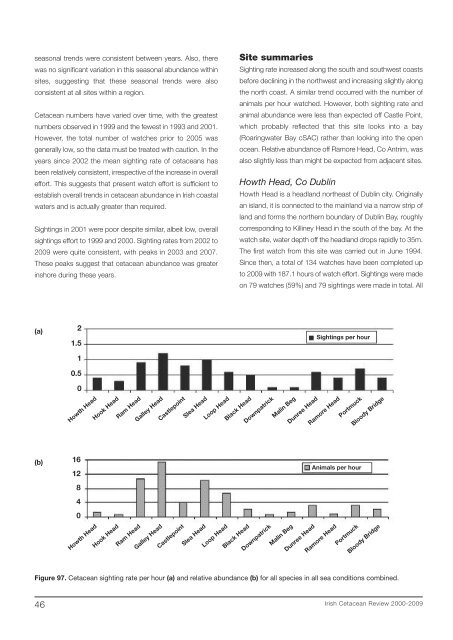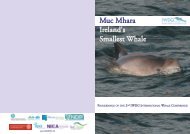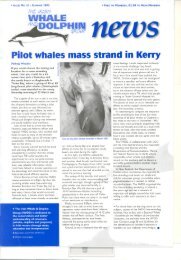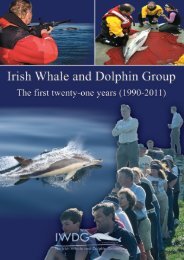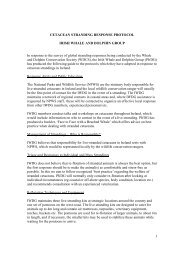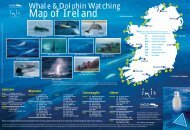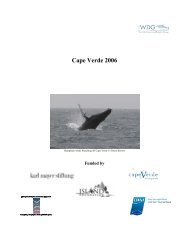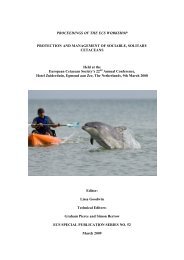downloaded here - Irish Whale and Dolphin Group
downloaded here - Irish Whale and Dolphin Group
downloaded here - Irish Whale and Dolphin Group
You also want an ePaper? Increase the reach of your titles
YUMPU automatically turns print PDFs into web optimized ePapers that Google loves.
seasonal trends were consistent between years. Also, t<strong>here</strong><br />
was no significant variation in this seasonal abundance within<br />
sites, suggesting that these seasonal trends were also<br />
consistent at all sites within a region.<br />
Cetacean numbers have varied over time, with the greatest<br />
numbers observed in 1999 <strong>and</strong> the fewest in 1993 <strong>and</strong> 2001.<br />
However, the total number of watches prior to 2005 was<br />
generally low, so the data must be treated with caution. In the<br />
years since 2002 the mean sighting rate of cetaceans has<br />
been relatively consistent, irrespective of the increase in overall<br />
effort. This suggests that present watch effort is sufficient to<br />
establish overall trends in cetacean abundance in <strong>Irish</strong> coastal<br />
waters <strong>and</strong> is actually greater than required.<br />
Sightings in 2001 were poor despite similar, albeit low, overall<br />
sightings effort to 1999 <strong>and</strong> 2000. Sighting rates from 2002 to<br />
2009 were quite consistent, with peaks in 2003 <strong>and</strong> 2007.<br />
These peaks suggest that cetacean abundance was greater<br />
inshore during these years.<br />
Site summaries<br />
Sighting rate increased along the south <strong>and</strong> southwest coasts<br />
before declining in the northwest <strong>and</strong> increasing slightly along<br />
the north coast. A similar trend occurred with the number of<br />
animals per hour watched. However, both sighting rate <strong>and</strong><br />
animal abundance were less than expected off Castle Point,<br />
which probably reflected that this site looks into a bay<br />
(Roaringwater Bay cSAC) rather than looking into the open<br />
ocean. Relative abundance off Ramore Head, Co Antrim, was<br />
also slightly less than might be expected from adjacent sites.<br />
Howth Head, Co Dublin<br />
Howth Head is a headl<strong>and</strong> northeast of Dublin city. Originally<br />
an isl<strong>and</strong>, it is connected to the mainl<strong>and</strong> via a narrow strip of<br />
l<strong>and</strong> <strong>and</strong> forms the northern boundary of Dublin Bay, roughly<br />
corresponding to Killiney Head in the south of the bay. At the<br />
watch site, water depth off the headl<strong>and</strong> drops rapidly to 35m.<br />
The first watch from this site was carried out in June 1994.<br />
Since then, a total of 134 watches have been completed up<br />
to 2009 with 187.1 hours of watch effort. Sightings were made<br />
on 79 watches (59%) <strong>and</strong> 79 sightings were made in total. All<br />
(a)<br />
2<br />
1.5<br />
1<br />
0.5<br />
Sightings per hour<br />
0<br />
Howth Head<br />
Hook Head<br />
Ram Head<br />
Galley Head<br />
Castlepoint<br />
Slea Head<br />
Loop Head<br />
Black Head<br />
Downpatrick<br />
Malin Beg<br />
Dunree Head<br />
Ramore Head<br />
Portmuck<br />
Bloody Bridge<br />
(b)<br />
16<br />
12<br />
Animals per hour<br />
8<br />
4<br />
0<br />
Howth Head<br />
Hook Head<br />
Ram Head<br />
Galley Head<br />
Castlepoint<br />
Slea Head<br />
Loop Head<br />
Black Head<br />
Downpatrick<br />
Malin Beg<br />
Dunree Head<br />
Ramore Head<br />
Portmuck<br />
Bloody Bridge<br />
Figure 97. Cetacean sighting rate per hour (a) <strong>and</strong> relative abundance (b) for all species in all sea conditions combined.<br />
46<br />
<strong>Irish</strong> Cetacean Review 2000-2009


